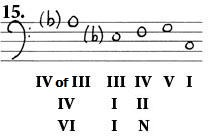1.3 - A practice of analysis in the tonal harmonic discourse from Bach to Wagner ||
A) FORMULAS - 1. Definition of
a formula ::
2. Presentation of
the little catalogue of harmonic vocabulary ::
3. User's guide to
the little catalogue and various instructions ::
4. Examples
illustrating the little catalogue (motifs: 1, 2, 3, 4, 5, 6a, 6b, 7, 8, 9, 10, 11, 12, 13, 14, 15, 16, 17, 18, 19, 20, motifs in combination)
B) SEQUENCES - 1. Definition of a
harmonic sequence :: 2. Classifying
sequences :: 3. Melodic
formulations: characteristic motifs :: 4. The tonal
nature of the harmonic sequence :: 5.The tripartite
structure of the harmonic sequence :: 6. A
modulating sequence or not? :: 7. Diversification
of harmonic content :: 8. The harmonic
sequence as a place of subversion :: 9. Conclusion
4. EXAMPLES ILLUSTRATING THE LITTLE CATALOGUE
Motif no 15

|
Example 269 : R. Wagner : Lohengrin, Act I, scene 3, Langsam (mm 6-9)

Example 270 : F. Chopin : Ballade no 4, op. 52 (mm 17-18)

Example 271 : J.S. Bach : Cantata BWV 38, final chorale, "Aus tiefer Not"

Example 272 : E. Grieg : The Old Mother, op. 33, no 7 (end)

Example 273 : E. Grieg : At Mother's Grave, op. 69, no 3 (mm 18-19)

motif no 16 
|
